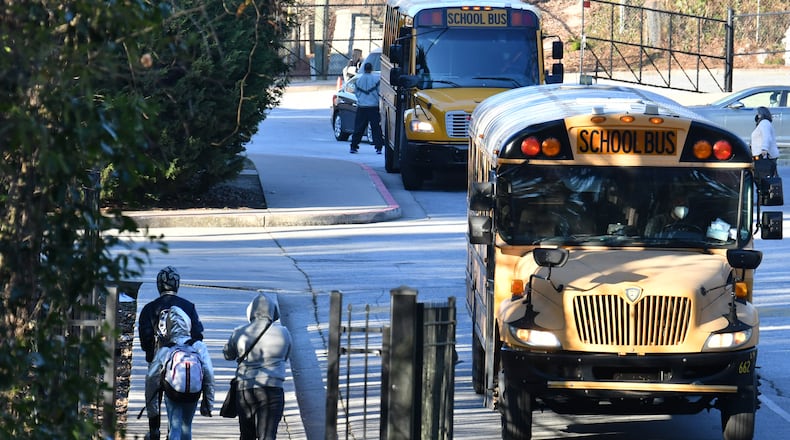Along the back fence of Crawford W. Long Middle School, white signs warn students and passersby not to venture beyond.
They’re a visible marker of an Environmental Protection Agency-led investigation into the health threat of a neighboring metal processing plant.
On Jan. 10, the EPA issued an emergency order warning that waste from a site run by TAV Holdings Inc. in south Atlanta could pose an “imminent and substantial” danger to humans and the environment. The EPA ordered that the plant in the Glenrose Heights neighborhood stop all activities that could release toxic waste.
The facility is located immediately behind the school, separated only by a steep hill, a creek and a chain link fence. Samples from the school and the creek that runs behind it were collected by the EPA on Jan. 17, and the results of those tests will determine the next steps, according to EPA spokesperson Davina Marraccini.
Based on the information already available, some experts fear that pollution from the site could threaten the health of children attending the school and those living nearby.
One of those is Eri Saikawa, an associate professor of environmental science at Emory University. In 2018, Saikawa led a team of students that uncovered widespread lead pollution in the soil on hundreds of properties in Atlanta’s Westside. The area was later added to the EPA’s Superfund list, a designation reserved for the country’s most dangerous hazardous waste sites.
Saikawa, who collected her own samples around the TAV site last summer, said that it is likely among the worst examples of industrial pollution she’s seen in the U.S. Based on her preliminary findings and those of the EPA, she said she would not be surprised if it, too, is eventually deemed a Superfund site.
“It’s both in the soil and the water and it’s current, so I think it needs to be stopped right away,” Saikawa said.
According to the federal agency’s order, the facility receives auto parts and other metal scraps bound for landfills, which it processes and separates into its metal constituents.
The plant did not have the proper permits, nor did it take the necessary precautions to keep waste laden with heavy metals from escaping the property, the EPA’s order says. Over the years, much of that waste ended up in the creek that runs along the northern edge of the TAV property, just yards away from the middle school, according to the EPA and past complaints received by Georgia’s Environmental Protection Division and the Atlanta Department of Watershed Management that were reviewed by The Atlanta Journal-Constitution.
Credit: HYOSUB SHIN / AJC
Credit: HYOSUB SHIN / AJC
The creek runs through lower-income residential neighborhoods before joining with another tributary that connects to the South River.
TAV did not respond to multiple calls and emails requesting comment. The company has been incorporated in Georgia since 2011, according to its filings with the secretary of state’s office.
The facility’s proximity to the school, as well as the high levels of lead and other metals found in waste that has migrated offsite, is what experts say is most alarming. Lead is a potent neurotoxin that can cause damage to the brain and the nervous system, particularly in children.
Credit: HYOSUB SHIN / AJC
Credit: HYOSUB SHIN / AJC
Samples that the EPA collected from on and off the TAV property showed lead concentrations that were well above the agency’s regulatory limits. One sample taken from the creek contained lead concentrations that were more than 13 times higher than what the EPA deems safe for residential soils.
Also concerning, experts say, are the huge mounds of dust-like waste still visible on parts of the site, just yards off of Empire Boulevard. Notes from the agency also reveal that inspectors observed that the material easily became airborne, and that children were spotted walking near the piles.
“The migration of the dust would be a particular concern because that would pose a potential inhalation exposure, and in general, inhalation exposures tend to be more toxic,” said Dana Barr, a professor at Emory University who has studied environmental health effects for more than three decades.
Shortly after the EPA issued its order, Atlanta Public Schools said it notified Crawford Middle School students and their families with a letter about the site. The school system said that paper letters were sent home with every student. Notices were also sent via the Remind app and by email, along with robo calls and texts. APS also said it has posted signs warning students and staff to stay off potentially affected parts of the campus.
In addition to notifying the school system, the EPA said it shared fact sheets with local elected officials, the neighborhood planning unit, a nearby church, and other stakeholders.
Credit: HYOSUB SHIN / AJC
Credit: HYOSUB SHIN / AJC
Still, most Crawford Middle parents that spoke with the AJC were unaware of the investigation.
Erica Jones, who lives two blocks from the school and is a parent of a sixth-grader, said she had noticed the large piles of dirt-like material on the TAV site before, but had heard nothing from the school or the EPA about the potentially toxic waste emanating from it.
“I see a lot of kids walk that way and a lot of them that wait for the bus, so I just want to know how it will affect our kids,” she said.
APS said its environmental team is working with the EPA and should have the test results by the end of February, which will be shared with the community at a virtual meeting soon after.
Credit: HYOSUB SHIN / AJC
Credit: HYOSUB SHIN / AJC
The plant has been on the EPD’s radar since at least 2017, when a complaint alleged the company was discharging wastewater into the creek behind the school. That complaint ended with an inspector finding that the facility was in compliance with the terms of its stormwater permit.
Another complaint to EPD surfaced in 2019 about discharges from the plant that were “strong in odor, dark, and very murky.” A notice of violation was issued by the EPD in June 2020.
Asked how the company was able to process scrap metal since 2015 without all of the necessary permits, an EPD spokesperson said in an emailed response that, “When EPD discovers activity that requires a permit is being conducted without one, we commence enforcement action. As we (and EPA) did here.”
About the Author
Keep Reading
The Latest
Featured







